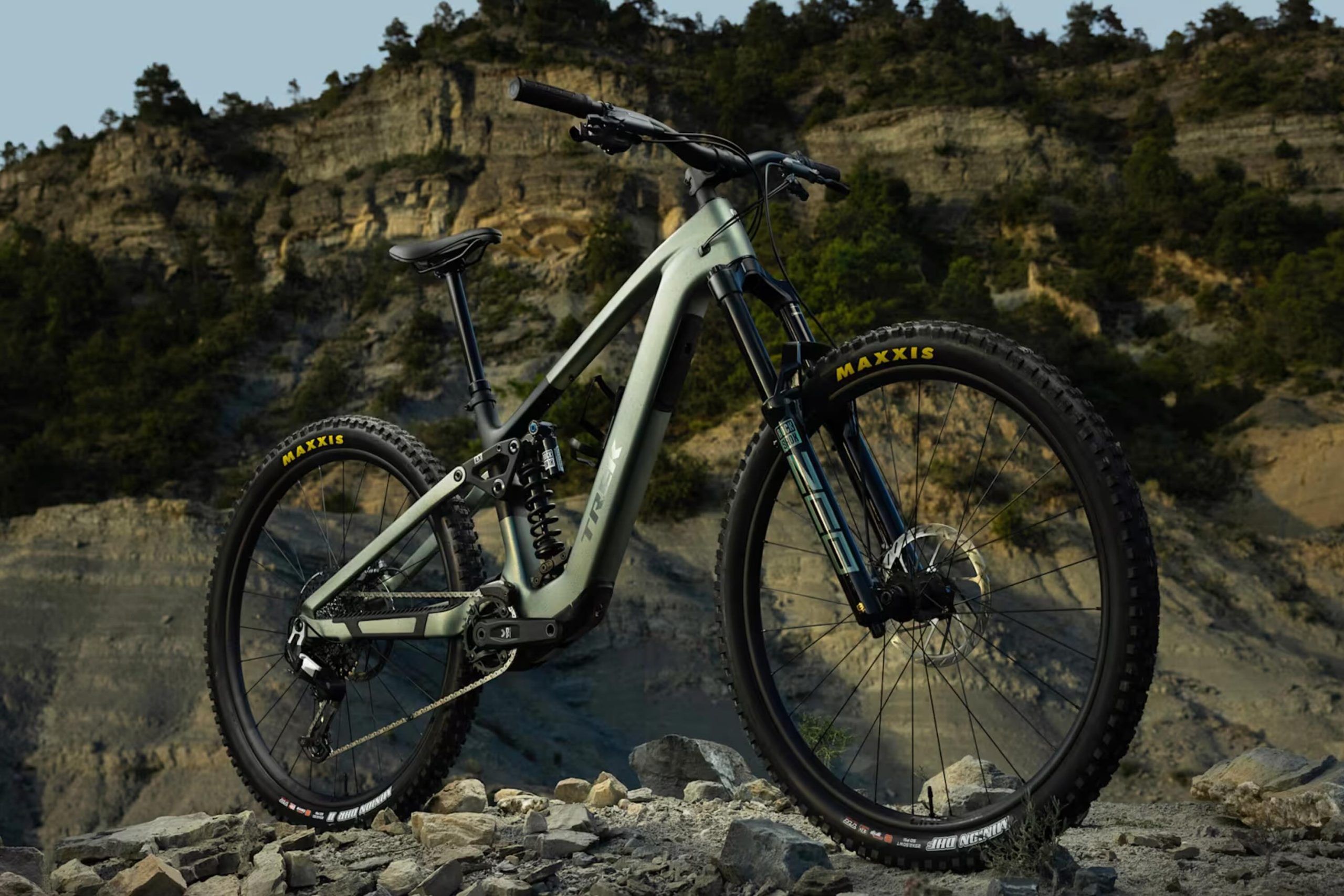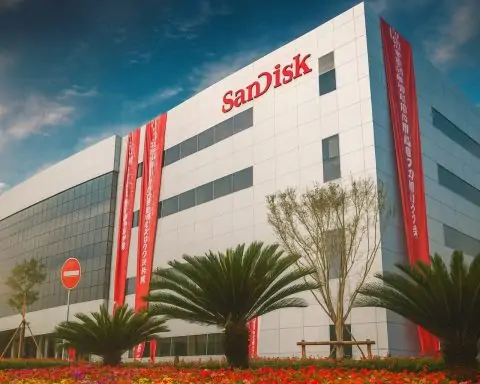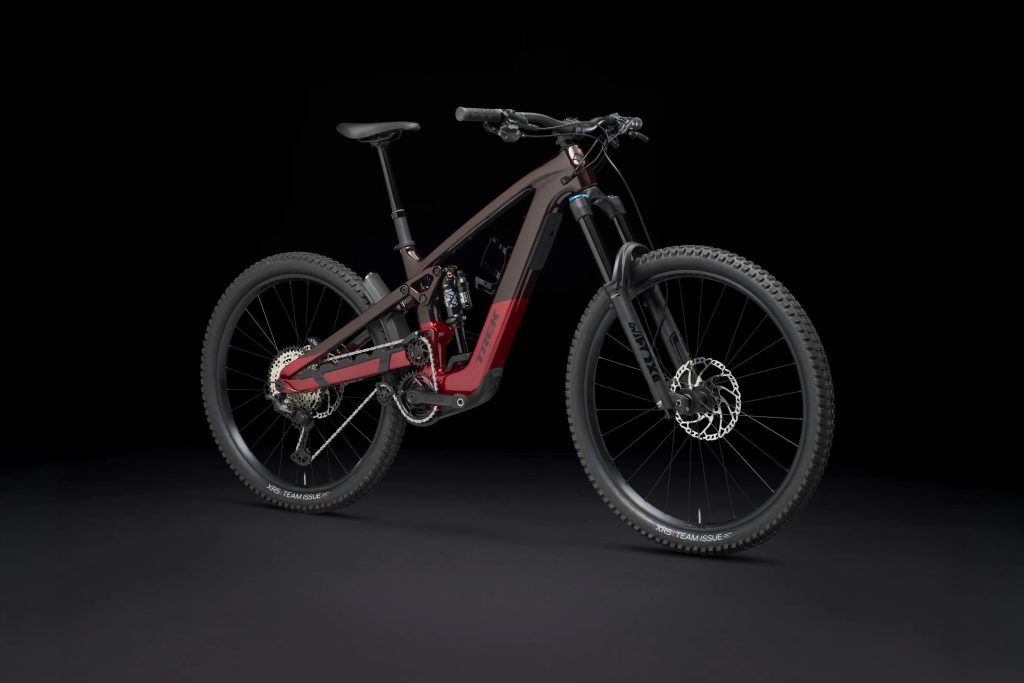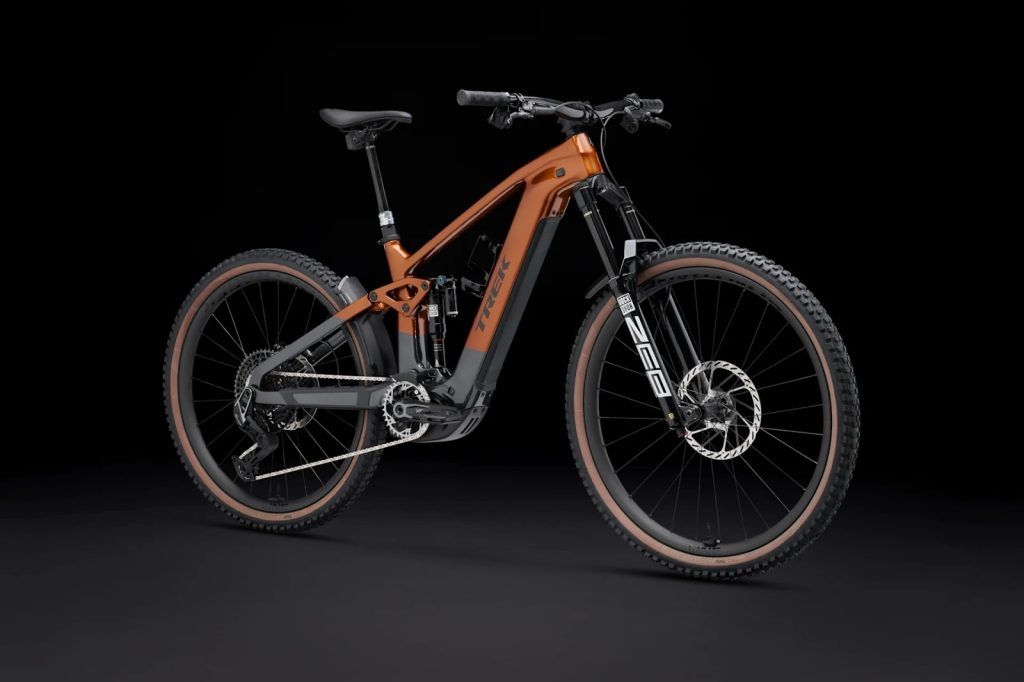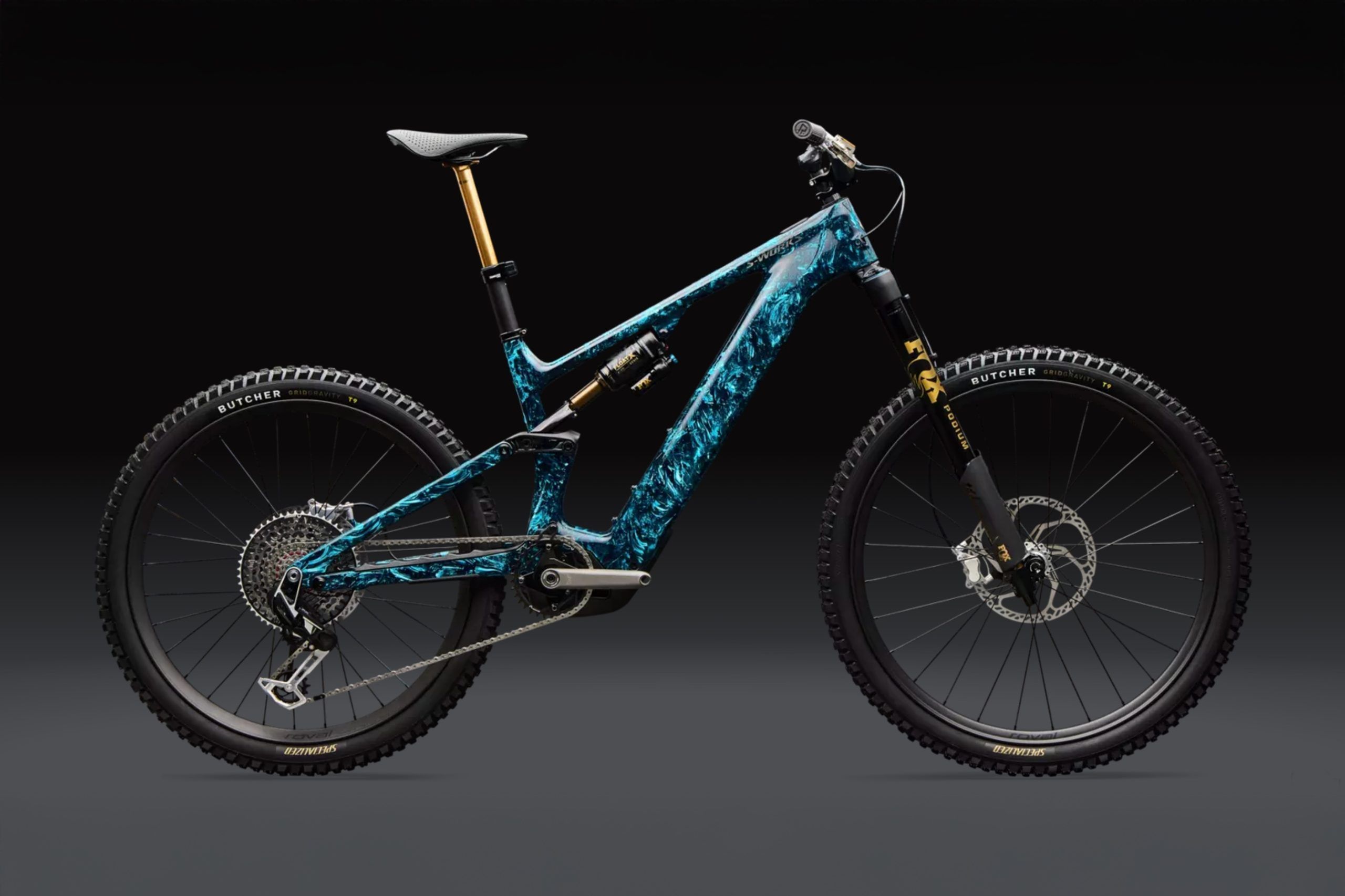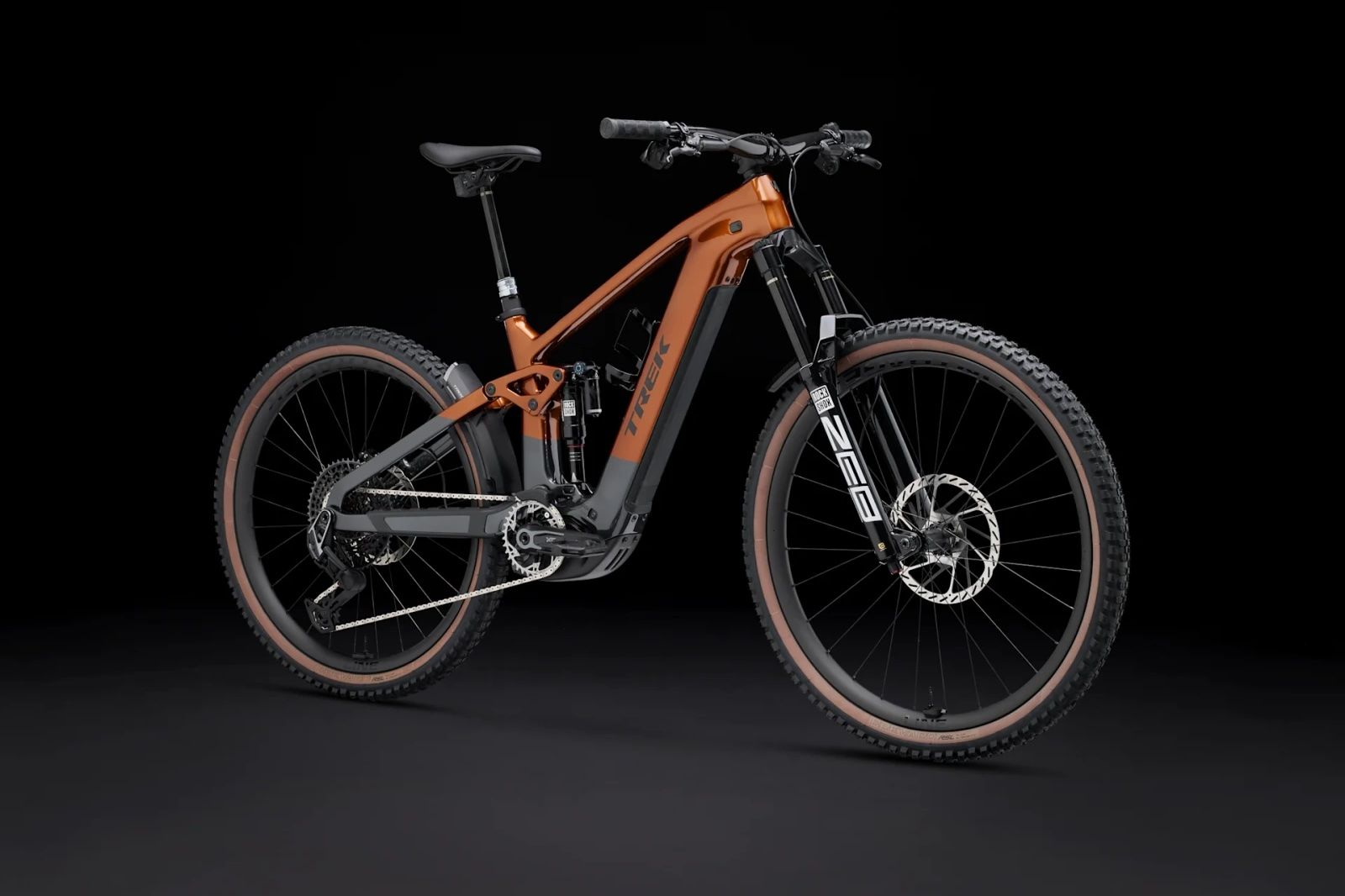- Next-Gen Boost: Trek’s new Fuel+ Gen 2 e-MTBs (2025) replace the original Fuel EXe with a more powerful motor (60 Nm vs 50 Nm) and a bigger 580 Wh battery for longer range [1] [2].
- Adaptable Configurations: The Fuel+ comes in EX, MX, and LX versions – offering 145 mm, 150 mm, or 160 mm of rear travel (with matching fork travel) and even mullet wheel options, all on one modular frame [3] [4].
- Evolution of a Lightweight E-MTB: The first-gen Fuel EXe (launched 2022) wowed riders with its stealthy design and quiet TQ-HPR50 motor, weighing as low as ~18.2 kg [5]. However, it was limited by a 360 Wh battery and was outgunned on power by competitors [6] [7].
- Performance & Ride Feel: Reviewers praised the Fuel EXe’s “nimble, natural ride” and near-silent assist [8] [9]. The new Fuel+ builds on that with stronger low-cadence torque and cooling enhancements for sustained output [10], aiming to deliver a more supportive yet still “invisible” boost on the trail.
- Pricing & Availability: Original Fuel EXe models saw steep discounts in 2024 (e.g. ~$6,500 down to ~$3,800 for a 9.5 Deore build) [11]. The Fuel+ Gen 2 lineup spans alloy and carbon models from around £4,400 (EX+ 5) up to £10,300 (9.9 X0 AXS) for the top spec [12] [13]. Trek also offers custom builds via Project One, especially for MX/LX configs [14].
- Looking Ahead: Trek’s e-MTB range is expanding – the Fuel+ covers the mid-power trail segment, while a separate Slash+ e-enduro (170 mm travel) is emerging for gravity riders [15] [16]. This unified “+” naming signals Trek’s commitment to TQ’s drive system and an era of lightweight e-bikes with heavier-hitting performance.
Trek Fuel EXe Gen 1: The Original Lightweight Trail E‑MTB
Trek launched the Fuel EXe in 2022 as a new breed of “slimmed-down” e-MTB. Instead of chasing maximum power, the EXe aimed for a “less is more” philosophy [17]. It used the innovative TQ HPR50 motor – a tiny harmonic pin-ring drive tucked into the frame – providing 50 Nm torque and a 300 W peak assist in a nearly silent, 1.85 kg package [18] [19]. The motor’s sound measured under 0.2 tu (tonality units), about five times less perceivable than other e-bike motors, allowing riders to stay “in the moment” without the typical e-whine [20]. With a 360 Wh internal battery, the Fuel EXe offered an estimated 2–5 hours of assist (extendable to 3–7.5 hrs with an optional 160 Wh range extender) [21] [22].
Trail Bike DNA: The Fuel EXe’s design was very close to a traditional trail bike. It featured 140 mm of rear suspension paired with a 150 mm fork [23]. The geometry mirrored Trek’s analog Fuel EX (Gen 6) – slack and capable up front with a 65° head tube angle, and a steep 77° effective seat tube angle for efficient climbing [24]. Thanks to the compact motor, Trek kept chainstays short at 440 mm, giving the bike lively handling [25]. A flip-chip Mino Link allowed a subtle 0.5° head angle and ~7 mm BB height adjustment to tune handling [26] [27]. (Notably, the alloy-framed EXe models could also accept angle-adjust headset cups for further tweaking [28].) The overall system weight was impressively low – the top-tier Fuel EXe 9.9 XX1 AXS weighed about 40.9 lbs (18.6 kg) in size M [29], roughly 10–12 lbs lighter than full-power e-MTBs of similar travel.
Models & Components: Trek initially offered the Fuel EXe as high-end carbon builds (9.7, 9.8, 9.9) with the OCLV Mountain Carbon frame, then later introduced more affordable variants (such as the EXe 5 and 8 with alloy frames) [30] [31]. For example, the entry Fuel EXe 9.5 came with a carbon frame but budget kit – Shimano Deore 12-speed drivetrain, a RockShox Gold RL 150 mm fork and Deluxe Select+ shock [32]. Higher trims like the 9.8 and 9.9 offered Fox or RockShox premium suspension and wireless shifting. No matter the trim, all shared the same motor and battery, meaning even the cheaper EXe’s delivered the full “light assist” experience. By 2023, Trek’s MSRP for the range spanned roughly $6,500 (for a 9.5) up to $14,000 (for the 9.9 XX1 AXS) [33] – though actual street prices later dropped significantly as we’ll note below.
Ride Reviews: The Fuel EXe quickly garnered praise for feeling almost like a regular bike. Bicycling magazine crowned it “the best e-mountain bike of 2023,” noting how light, discreet, and quiet it was – “proving that more doesn’t make e-bikes better” [34]. Riders loved that the EXe “rides like an unpowered bike” with a natural, lag-free boost and minimal drag [35] [36]. At 250 W nominal output (300 W peak), the assist wasn’t about shredding climbs at warp speed, but rather smoothing out the effort. As one reviewer put it, the EXe’s boost feels “like an extension of your own power”, instead of a jolting push [37] [38]. The ultra-quiet motor also drew applause – “remarkably quiet, even in the highest assist…so discreet that every time I jump on a full-powered e-MTB, it feels like I’m riding a vacuum cleaner,” wrote Flow MTB [39] [40]. That harmonious ride experience made the Fuel EXe “one of the most agile and enjoyable electric mountain bikes we’ve ever ridden,” according to Flow’s long-term test [41].
At the same time, limitations became apparent as competitors launched beefier “mid-power” e-bikes. With only 50 Nm torque and a small battery, the Fuel EXe wasn’t built for sustained turbo boosts or day-long epics. In a group test of lightweight e-MTBs, MBR found the Trek underpowered on big climbs – “with just 300 W peak power, and limited range, the Trek Fuel EXe 9.7 won’t do the hard yards for you” [42]. And while the 360 Wh battery excelled for 2–3 hour trail rides, it necessitated carrying the range extender for longer adventures. These factors, plus fierce new competition (Specialized’s Turbo Levo SL Gen2, Orbea Rise updates, etc.), led Trek to heavily discount the EXe in 2024. By mid-2025, some high-end models were on sale for over 50% off their original price [43] [44]. For example, a Trek dealer listed the Fuel EXe 9.5 at $3,799 (down from $6,499) – an “outrageous” deal that many savvy buyers snapped up [45] [46]. This clear-out signaled an incoming replacement – and indeed, Trek soon unveiled the Fuel+ Gen 2 series as the EXe’s successor.
Trek Fuel+ Gen 2: More Power, More Travel, More Adaptability
Caption: The new Trek Fuel+ (Gen 2) in the EX configuration (145 mm rear travel, 150 mm fork). While it retains the clean look and carbon frame of its predecessor, the Fuel+ packs a stronger TQ HPR60 motor and a larger 580 Wh battery under the hood [47] [48].
In August 2025, Trek relaunched the Fuel EXe under a new name – “Fuel+” – marking the bike’s second generation with some substantial upgrades [49] [50]. The rebrand aligns this model with Trek’s other e-MTBs (like the Rail+ and new Slash+), but it’s far more than a name change. The Fuel+ Gen 2 introduces a revised frame and component package that addresses the original’s weaknesses and dramatically boosts versatility.
HPR60 Motor – Small Bump in Power: At the heart of the Fuel+ is TQ’s latest mid-drive unit, the HPR60, which replaces the prior HPR50. It looks almost identical from the outside – still ultra-compact and tucked neatly by the bottom bracket – but delivers a bit more grunt. The HPR60 is rated at 60 Nm of torque (a 20% increase) and up to 350 W peak output [51] [52]. Importantly, it’s tuned to engage that torque at a lower cadence than before, meaning the assist feels stronger right from the slow, technical climbs [53]. Despite the power bump, the motor remains very lightweight (about 1.9 kg [54]), and is reportedly even quieter and more efficient than its predecessor [55]. Trek integrated additional cooling fins into the motor area to ensure consistent performance on long, hot descents or extended climbs [56] [57].
Interestingly, Trek has made the new HPR60 backwards-compatible with existing Fuel EXe frames – determined owners can retrofit the higher-torque motor into a Gen 1 bike [58] [59]. (The catch: Trek will only stock HPR60 units for warranty, so upgrade-seekers must go through TQ directly, and the motor’s firmware will still limit it to 300 W in the old EXe to avoid overheating issues [60].) Also backward-compatible is the EXe’s integrated display, which in Fuel+ gets a welcome upgrade to a full-color LED screen on higher-end models (9.8 and 9.9) [61] [62]. The new display in the top tube offers clearer ride metrics at a glance, though lower-tier builds continue with the simple monochrome readout to save cost.
580 Wh Battery – Big Range Boost: The other major boost is in the battery department. Fuel+ squeezes in a significantly larger 580 Wh removable battery pack (the same used in Trek’s burly Slash+ enduro e-bike) [63]. This is a 61% increase in capacity over the original 360 Wh unit – a response to riders’ calls for more range. Despite the higher capacity, Trek kept the battery removable via two bolts and a downtube cover, so you can still swap packs or pull it for off-bike charging [64]. The new battery remains compatible with TQ’s 160 Wh range extender, so epic all-day rides (740 Wh total) are on the table [65]. Naturally, the bigger battery carries a weight penalty – the bike gains roughly 0.5–1 kg over the EXe, depending on model. But most riders will happily trade a bit of weight for the extended ride time. (For those really weight-conscious, TQ’s system theoretically allows using a smaller 360 Wh pack in the same space [66], though Trek doesn’t officially offer a swap – some third-party tinkering might make it possible to “downsize” the battery for a big weight savings on race days.)
Three Bikes in One Frame: Perhaps the coolest innovation of the Fuel+ platform is its adaptable geometry and travel. Trek essentially combined the roles of the old Fuel EXe, Remedy, and Slash (in part) into one configurable frame [67]. Out of the box, the Fuel+ is offered in three configurations:
- Fuel+ EX: 145 mm rear travel, 150 mm fork, 29″ wheels front & rear (the default “trail” setup) [68].
- Fuel+ MX: 150 mm rear, 160 mm fork, mixed wheels (29″ front, 27.5″ rear). This mullet setup has a slightly more progressive leverage rate and a playful, “popppy” attitude – “ideal for getting zesty on side hits and railing tight turns,” essentially reviving the spirit of the old Trek Remedy [69].
- Fuel+ LX: 160 mm rear, 170 mm fork, 29″ wheels – a long-travel bruiser approaching enduro territory [70] [71]. The LX is the choice for riders wanting near-Slash levels of travel without the high-pivot complexity of Trek’s dedicated Slash+ bike [72]. It even comes stock with a coil shock on some builds for a park-ready setup [73].
Crucially, these aren’t three entirely separate models – they’re three configurations of the same platform. Trek’s engineers designed the frame with interchangeable rocker links and lower shock mounts so that owners can swap their bike between EX, MX, or LX modes if desired [74] [75]. Each configuration gets a dedicated linkage that corrects the geometry for that travel and wheel setup, ensuring things like BB height, head angle, and suspension kinematics stay on point [76]. (In other words, no kludgy “just throw a longer fork on” compromises – every travel change is geometry-corrected by design [77].) Switching to MX or LX does require the new rocker links (and a longer-stroke shock for LX) [78] [79], but Trek plans to sell aftermarket link kits to make conversions straightforward [80]. In fact, in some markets Fuel+ is only stocked in EX form, with MX/LX offered via Project One custom orders or DIY conversion kits [81]. This approach simplifies the retail lineup while still giving enthusiasts the choice of mullet or longer travel if they want it. EMTB Forums insiders noted how impressive it is from a product management perspective – Trek effectively “gets all of that from one frame”, reducing complexity and cost for the company (and potentially for consumers down the line) [82] [83].
Frame & Geometry Updates: The Fuel+ frame might look similar to the EXe at a glance – it retains the sleek OCLV carbon (or Alpha aluminum on lower models) with full internal cable routing and a one-piece triangled front end – but it has been tweaked in many areas. Trek increased standover clearance and seatpost insertion depth, such that most riders can now fit longer dropper posts (indeed, size Large Fuel+ bikes come with 200 mm travel droppers standard) [84]. They also added integrated accessory mounts on the top tube for tools or snacks, and ensured the main triangle has room for a water bottle or a range extender even on the smallest sizes [85]. The suspension maintains Trek’s Active Braking Pivot (ABP) linkage, but now includes a leveraged rate adjust chip – riders can flip a chip on the lower shock mount to choose a more progressive or less progressive rate, fine-tuning how the bike behaves on big hits [86]. Additionally, Trek moved to a standardized zero-stack headset which makes installing angle-adjust cups easy if a rider wants to slacken or steepen the head angle beyond stock [87]. (Many of these updates parallel the 2026 analog Fuel EX Gen 7, which launched alongside the Fuel+ and shares an identical geometry chart [88] [89].)
Speaking of geometry, the Fuel+ (in EX 29er form) comes stock with a 64.5° head tube angle, slightly slacker than the Gen 1 Fuel EXe’s 65° [90]. Thanks to the new sizing scheme, reach figures are a bit roomier (e.g. 485 mm in size Large) and an XXL size is now offered, extending reach to 530 mm for very tall riders [91]. Trek also implemented size-specific chainstays – shorter on S/M (437 mm) and longer on XL/XXL (447–452 mm) to keep handling balanced as frame size grows [92]. Effective seat tube angles still hover in the steep 76–78° range (size dependent) to optimize climbing position [93]. Notably, those geo figures are identical whether you’re on the Fuel+ e-bike or the new analog Fuel; aside from weight and motor differences, the handling and fit between the two platforms should feel the same [94]. This is a testament to how “invisible” the TQ system is – Trek didn’t have to significantly compromise geometry for the e-version.
Despite packing more travel and a larger battery, the Fuel+ manages to keep weight in check. Carbon models build up in the low 20 kg range (a Fuel+ EX 9.8 with XT Di2 is ~22 kg, according to one shop), while the alloy Fuel+ 5 is heavier but still far from a full-power tank. All builds get powerful 4-piston brakes and appropriately burly components to handle aggressive riding. In essence, the Fuel+ brings “more power, more travel, more component choice” to what was already an award-winning chassis [95].
Model Lineup & Specs Comparison
Both generations of Trek’s light e-MTB cover a spread of builds, from more affordable alloy models to no-expense-spared carbon superbikes. Here’s how the Fuel EXe Gen 1 vs. Fuel+ Gen 2 lineups break down:
- Fuel EXe (Gen 1) Models (2022–2024): Initially all-carbon, Trek later added alloy trims. Key models included:
- Fuel EXe 9.5 – Carbon frame, RockShox 35 Gold RL 150 mm fork, Deluxe Select+ shock (140 mm), Shimano Deore 12-speed; base spec but the lowest cost carbon entry [96].
- Fuel EXe 9.7 – Carbon frame, up to SLX/XT grade components (varied by year). Often came with Fox 36 Rhythm or RS Lyrik Select fork and a mid-level drivetrain (Shimano SLX/XT or SRAM GX). A popular mid-range choice.
- Fuel EXe 9.8 – Carbon frame, higher-end suspension (e.g. Fox Factory or RockShox Lyrik/SuperDeluxe with latest dampers) and options for Wireless shifting. Trek offered sub-variants like a 9.8 XT, a 9.8 GX AXS, etc., typically around the sweet-spot ~$8–9k USD range.
- Fuel EXe 9.9 – Top-of-the-line carbon build. Featured the best of everything: e.g. Fox Factory suspension, SRAM XX1 AXS or Shimano XTR, carbon wheels. Priced in five figures (originally ~$13–14k). This was the lightest of the lot (~18.5 kg) [97].
- Fuel EXe 5 / 7 / 8 – Alloy frame versions introduced later to hit lower price points (EXe 5 around $5k). For example, the EXe 5 had a RockShox 35 Silver fork and SX/Deore-tier parts, while an EXe 8 could come with GX or XT and even a dropper post. These still used the same 360 Wh battery and HPR50 motor, giving similar performance at a heavier weight but great value.
- Fuel+ (Gen 2) Models (2025– present): With the Gen 2 launch, Trek greatly expanded the number of build options. In fact, MBR reports there are 15 distinct Fuel+ models when you consider EX/MX/LX variants [102]. The range includes:
- Fuel EX+ 5 – Alloy frame, base model. Equipped with a RockShox Recon Silver or Judy fork, X-Fusion rear shock [103], and Shimano Deore 1×12 drivetrain with 4-piston brakes [104]. This is the entry point, starting around £4,400 (approx $5,000). Despite the lower cost, it still gets the full HPR60 motor and 580 Wh battery [105].
- Fuel EX+ 8 – Alloy frame, step-up build. Notably specced with a stouter Fox Rhythm 36 fork and Float X shock, SRAM GX Eagle or Shimano XT drivetrain (varies by region), and stronger wheels/components [106]. Priced around £5,000. Essentially, the EX+ 8 adds trail-worthy parts to match the bike’s capabilities, while keeping the cost in check.
- Fuel EX+ 9.7 – Carbon frame starts at this level [107]. The 9.7 is an incredible value point because for ~£5,500 you get the lightweight carbon chassis with the same parts as the EX+ 8 [108]. Many see this as the sweet spot – you shed a couple pounds going carbon without needing to upgrade parts immediately.
- Fuel EX+ 9.8 – Carbon frame, high-performance kit. There are multiple 9.8 sub-models: one comes with Shimano XT drivetrain and Fox Factory suspension [109], another “EX 90” edition features a SRAM X0 Eagle (T-Type) drivetrain and RockShox Lyrik Ultimate fork [110] – both priced similarly (~£7,625) so riders can choose Shimano or SRAM flavor [111]. There’s even a 9.8 XT Di2 variant that includes Shimano’s new XT-level electronic shifting and Fox Factory suspension at around £8,950 [112]. All 9.8 versions come with top-tier suspension components (Factory or Ultimate) and are ready for hard charging.
- Fuel EX+ 9.9 X0 AXS – The range-topper at £10,300 MSRP [113]. This model spares no expense: OCLV carbon frame, RockShox Ultimate suspension (likely a Lyrik Ultimate and SuperDeluxe Ultimate, or possibly a ZEB for LX builds), SRAM X0 AXS wireless shifting, carbon wheels, etc. [114] [115]. Interestingly, Trek offers 9.9 trims in each configuration (EX, MX, LX) through its dealer network or Project One, so a buyer can get the flagship build in whichever travel/wheel format they prefer [116] [117]. For instance, the Fuel+ LX 9.9 X0 AXS comes stock with a coil shock and Fox 38 Factory fork to suit its 160/170 mm travel, whereas an EX 9.9 X0 AXS might come with a slightly lighter setup (RockShox Lyrik fork, air shock) for trail use [118] [119].
For context on pricing, the Fuel+ series is positioned a bit lower than some competitors in the “mid-power” segment. For example, Yeti’s new 2025 Mdt e (which also uses the TQ HPR60 and a 580 Wh battery) starts around $10k for the C2 build and goes to $13k+ [123]. Specialized’s latest Levo SL (50 Nm, 320 Wh) runs ~$8k–$15k. Trek offering a carbon frame e-MTB at ~£5.5k (the 9.7) is relatively aggressive. And the alloy EX+ 5 at ~$5k USD puts a modern TQ-powered bike within reach of far more riders than the first-gen EXe ever was. Also, the blow-out sales of Gen 1 mean there are some amazing deals on remaining stock – a few retailers and resellers are offering certified used Fuel EXe 9.5’s for 40–60% off [124] [125], which is tempting if ultimate power/range aren’t needed.
On-Trail Performance and Ride Impressions
Early impressions of the Fuel+ Gen 2 suggest Trek has built upon the EXe’s best traits while remedying its shortcomings. The original Fuel EXe was loved for its handling and subtle assist, and those qualities remain a focus in Gen 2. “The Fuel EXe is a damn fine mountain bike…with its sleekly integrated and well-tuned motor, it becomes one of the most compelling bikes in recent memory,” wrote one tester [126]. That fundamental “normal bike” feel has not been lost – the HPR60 motor still freewheels with virtually no drag, and in the lowest assist mode you might forget it’s even there. However, when you do dial up the power, the Fuel+ now has a noticeable extra kick. Test riders report the torque comes on more strongly at low RPMs, making technical climbs easier to clear without shifting to an easier gear. Trek’s product manager David Knauf explained they tuned the new motor to be “more supportive from the get-go” – addressing a minor gripe that the EXe could feel a tad sluggish until you spun up to higher cadence [127]. In essence, the Fuel+ feels torquier and more responsive under load, bridging the gap toward full-power e-bike climb performance, yet it still tops out at the standard 20 mph assist limit like any class 1 e-MTB.
The extra travel and stiffness of the Fuel+ frame also shine when the trail points down. Where the Gen 1 EXe was already “mighty capable” for 140 mm, especially after testers swapped to a 160 mm fork [128] [129], the new Fuel+ in LX trim is a true mini-enduro machine. With a 170 mm Fox 38 up front and 160 mm out back (in coil-sprung form), reviewers say the bike charges through rough terrain with confidence – feeling closer to a Trek Slash (analog or e-) than to the old EXe. Yet, thanks to the modular design, the very same bike can be configured back to a 145 mm 29er and feel agile and efficient on tamer trails. This adaptability has drawn praise as a game-changer for riders who want one bike to do it all. As one forum user joked, “cheaper bikes for us (lmao, lol, haha)” – implying that while the Fuel+ isn’t cheap per se, it could save the cost of owning multiple bikes by being so easy to transform [130].
Expert Reviews & Quotes: Formal reviews of the Fuel+ Gen 2 are just starting to hit press as of late 2025. MBR magazine’s first ride highlighted that Trek “keeps the brilliant EXe frame and adds more power and choice”, noting the new model’s versatility and improved motor torque [131] [132]. The author, who had criticized the EXe 9.7 in a group test, admitted he “didn’t give up on the Fuel EXe” and even made it his Bike of the Year 2024 after extensive testing [133]. His takeaway on Fuel+ was positive – essentially that Trek answered the call by supercharging an already excellent chassis.
Meanwhile, riders continue to rave about the core riding experience inherited from Gen 1. The Fuel EXe taught a lot of skeptics that an e-MTB could be “light, quiet and ride just like a traditional bike”. Bicycling noted that as e-bikes get “quieter, sleeker, and less obvious (like this EXe), it will be increasingly difficult to tell them apart from unpowered bikes”* [134]. That’s exactly the vibe the Fuel+ carries forward – in fact at a glance, one might not spot any difference aside from the “Fuel+” logo. The new motor is still near-silent – TQ claims it’s even quieter in terms of pitch, likely thanks to better cooling and maybe refined internals [135]. A reviewer from NSMB who rode the original described the TQ motor as “as quiet as a ninja in a library” [136] – and the Fuel+ intends to keep ninjas gainfully employed. There’s none of the rattling noise or clunky engagement that heavier Bosch/Shimano motors can exhibit [137] [138]. This stealth factor is a huge selling point for riders who want the benefits of assist without the “e-bike feel” or sound.
One recurring con for the EXe was its limited battery size – something Fuel+ decisively tackles. With 580 Wh on tap, the Gen 2 bike can confidently handle 4–5 hours of spirited trail riding [139] [140]. In fact, Bike-EU reports that TQ’s HPR60 system is designed to work with 290 Wh, 360 Wh or 580 Wh batteries [141], giving manufacturers flexibility. Trek went for the largest to maximize range, which suggests they heard the feedback loud and clear. The only downside is a slight weight increase and the fact that existing EXe owners can’t simply pop in the bigger battery (the frame had to be tweaked to fit it). However, those EXe owners can rejoice that their bikes aren’t totally obsolete – the ability to retrofit the new motor means an EXe could get a torque boost (to ~60 Nm) if one is determined to upgrade [142]. And since the extender battery remains the same, they can still benefit from the 160 Wh piggyback for big days.
Trek also improved the user interface on Fuel+. The new color display on 9.8/9.9 models is easier to read in bright light and shows more data at once (like a battery % indicator, assist mode color coding, etc.). The minimalist bar remote remains, with intuitive mode toggling and walk-assist. Little quality-of-life tweaks like a smarter charge port (now better sealed and positioned) and refined cable routing were carried over from late updates to the EXe. And importantly, the serviceability of the bike stays good – remove two bolts and the downtube opens to drop out the battery [143], and the motor is held with accessible hardware too. Trek even made the rocker links two-piece alloy constructions (instead of one-piece) to reduce manufacturing costs and make future replacements cheaper [144].
In summary, the Fuel+ Gen 2 series elevates Trek’s e-trail bike to modern standards. It retains the soul of the Fuel EXe – that “analog mountain bike feel” – which won it accolades (including a Design & Innovation Award in 2023 for ushering in a new era of light e-MTBs [145]). But it layers on meaningful improvements: more power, more range, and more versatility. For a prospective buyer, the new Fuel+ is a compelling package: it’s one of the very few e-MTBs that can transform from a snappy trail bike to a long-travel enduro machine by swapping a few parts. It’s also future-proofed with cutting-edge electronics (wireless shifting options, forward-compatible motor tech) yet doesn’t abandon practicality (standard wheel sizes, removable battery, etc.). As one industry commentator noted, the Fuel+ shows that Trek is doubling down on the “mid-power” e-bike concept – betting that riders do want that lighter, quieter e-bike experience but with just a bit more oomph and capability than first-gen bikes offered [146] [147]. Given the buzz around similar bikes (Specialized’s Turbo Tero X, Pivot’s Shuttle SL, Orbea Rise, Yeti M̶T̶e̶), Trek is hitting the timing perfectly with Fuel+.
Market Trends and Future Outlook
The launch of the Trek Fuel+ Gen 2 comes at a pivotal time in the e-MTB market. A few years ago, riders had a stark choice: “full power” e-bikes (with ~85 Nm motors and 700+ Wh batteries, but 50 lb weights) or “super-light” e-bikes (35 Nm motors, 250 Wh batteries, very light but low assist). The original Fuel EXe sat in between these extremes as a mid-power, mid-weight option, and it turns out that middle ground is where a lot of riders found their happy place. Since then, the industry has seen a flurry of activity in this segment:
- Specialized Turbo Levo SL (Gen 2): Specialized updated their SL e-bike in 2023, increasing torque to ~50 Nm and battery to 320 Wh (with extender) – very close to the EXe’s formula. They prioritized low weight and refined power delivery, much like Trek did.
- Orbea Rise: Orbea’s Rise models pioneered the idea of tuning a Shimano motor down to 60 Nm and pairing it with a smaller battery (360 Wh or 540 Wh) for a lighter ride. The Rise proved quite popular, and its success validated the market for “less than full power” e-MTBs. Trek’s EXe essentially took this concept further with an even quieter motor.
- New Players with TQ HPR60: Not only Trek, but other high-end brands have adopted the TQ HPR60 system in their latest bikes. Yeti’s 2025 Mḗ (pronounced “M-T-E”) is one example – a 150 mm trail e-bike powered by the same HPR60 and a 480–580 Wh battery, weighing ~43 lbs [148]. BMC and Transition are also rumored to be working on models with the TQ system. This trend suggests the HPR50/60 platform has proven itself and we might see it become as ubiquitous in mid-power e-bikes as Bosch is in full-power rigs.
- Unified Lineups & Naming: Trek renaming the EXe to Fuel+ (and introducing a Slash+ for 170 mm e-enduro [149]) reflects a strategy to unify their e-bikes under the “+” moniker. We can likely expect a Rail+ or similar for the next-gen full-power bike, perhaps moving away from Bosch to an in-house TQ solution across the board. (The current Trek Rail uses Bosch, but Trek’s collaboration with TQ might hint at a future high-torque TQ motor – maybe an HPR85 – that could eventually power a Rail+ with say 85 Nm and 720 Wh, eliminating reliance on third-party motors. Pure speculation, but not far-fetched as TQ’s tech scales up.)
- Consumer Demand: Riders today are asking for e-MTBs that feel like normal bikes – meaning less weight, less noise, and intuitive handling – yet don’t want to be left underpowered when chasing friends on full-fat e-bikes. The response has been bikes like the Fuel+, which blur the lines by giving ~60 Nm torque (enough for all but the steepest climbs to feel easy) in a package ~10 kg lighter than a full-power bike. This “have your cake and eat it” approach is driving sales. Many who were e-bike skeptics have warmed up to the idea once they test rode a quiet, mid-power model that doesn’t overpower the trail experience.
As for the Trek Fuel+ series itself, the future looks bright. The Gen 2 has just hit the market, and Trek will likely continue refining it in coming model years. Perhaps we’ll see even lighter carbon layups or an EXe 9.9 “SLR” version in the future dropping a kilo. Or Trek could experiment with smaller battery options (since the frame can fit the big one, a half-size pack could be an accessory for race days). But for now, the Fuel+ covers a huge swath of rider needs, from casual trail riding in EX form to all-mountain rowdiness in LX form.
Finally, Trek’s embrace of modularity and customization (via Project One and aftermarket link kits) is likely to influence other brands. Why sell three separate bike models when one frame can do it all? We may see competitors follow suit with modular designs. For consumers, that means more value and flexibility – trends we can all cheer for.
Bottom Line: The Trek Fuel+ Gen 2 series is a comprehensive upgrade that keeps the bike at the forefront of the e-MTB conversation. By supercharging the Fuel EXe’s platform with more power, more range, and more adaptability, Trek has created an e-bike that truly “brings endless versatility to any trail” [150]. Whether you’re an “e-curious” rider looking for your first e-MTB or a seasoned rider seeking the one do-it-all machine, the Fuel+ deserves a spot on your short list. With its quiet nature and dynamic personality, it just might make you forget it’s electric – until you cruise past your buddies on the climbs and smash through another epic loop with battery to spare. In the Fuel+ Gen 2, Trek has effectively turned the dial up to 11 on the light e-MTB experience, while still keeping things feeling natural and fun [151] [152]. That’s a balance many riders will find very exciting as the next chapter of e-mountain biking unfolds.
Sources: Trek Bikes official announcements and specs; expert reviews from Flow Mountain Bike, MBR, Bicycling, Loam Wolf; dealer listings and user forums for real-world insights [153] [154] [155] [156] [157], etc. These collectively provide a detailed comparison of the Fuel EXe and Fuel+ series in terms of technology, performance, and market context.
References
1. flowmountainbike.com, 2. theloamwolf.com, 3. flowmountainbike.com, 4. www.emtbforums.com, 5. flowmountainbike.com, 6. www.mbr.co.uk, 7. www.mbr.co.uk, 8. flowmountainbike.com, 9. www.bicycling.com, 10. theloamwolf.com, 11. northstarsportsvt.com, 12. www.mbr.co.uk, 13. www.mbr.co.uk, 14. flowmountainbike.com, 15. www.mbr.co.uk, 16. www.emtbforums.com, 17. www.bicycling.com, 18. www.trekbikes.com, 19. www.trekbikes.com, 20. www.trekbikes.com, 21. www.trekbikes.com, 22. northstarsportsvt.com, 23. northstarsportsvt.com, 24. www.trekbikes.com, 25. www.trekbikes.com, 26. www.trekbikes.com, 27. flowmountainbike.com, 28. www.trekbikes.com, 29. www.bicycling.com, 30. www.trekbikes.com, 31. www.trekbikes.com, 32. northstarsportsvt.com, 33. www.bicycling.com, 34. www.bicycling.com, 35. www.bicycling.com, 36. www.bicycling.com, 37. www.trekbikes.com, 38. www.trekbikes.com, 39. flowmountainbike.com, 40. flowmountainbike.com, 41. flowmountainbike.com, 42. www.mbr.co.uk, 43. www.mbr.co.uk, 44. www.mbr.co.uk, 45. northstarsportsvt.com, 46. www.mbr.co.uk, 47. flowmountainbike.com, 48. theloamwolf.com, 49. www.mbr.co.uk, 50. flowmountainbike.com, 51. flowmountainbike.com, 52. www.pinkbike.com, 53. theloamwolf.com, 54. flowmountainbike.com, 55. flowmountainbike.com, 56. www.emtbforums.com, 57. www.emtbforums.com, 58. flowmountainbike.com, 59. www.mbr.co.uk, 60. www.mbr.co.uk, 61. flowmountainbike.com, 62. theloamwolf.com, 63. flowmountainbike.com, 64. flowmountainbike.com, 65. theloamwolf.com, 66. mbaction.com, 67. www.emtbforums.com, 68. flowmountainbike.com, 69. theloamwolf.com, 70. flowmountainbike.com, 71. theloamwolf.com, 72. theloamwolf.com, 73. www.mbr.co.uk, 74. flowmountainbike.com, 75. flowmountainbike.com, 76. theloamwolf.com, 77. theloamwolf.com, 78. www.mbr.co.uk, 79. www.emtbforums.com, 80. flowmountainbike.com, 81. flowmountainbike.com, 82. www.emtbforums.com, 83. www.emtbforums.com, 84. www.emtbforums.com, 85. theloamwolf.com, 86. www.emtbforums.com, 87. theloamwolf.com, 88. flowmountainbike.com, 89. flowmountainbike.com, 90. www.trekbikes.com, 91. flowmountainbike.com, 92. flowmountainbike.com, 93. flowmountainbike.com, 94. flowmountainbike.com, 95. www.mbr.co.uk, 96. northstarsportsvt.com, 97. www.bicycling.com, 98. flowmountainbike.com, 99. flowmountainbike.com, 100. flowmountainbike.com, 101. flowmountainbike.com, 102. www.mbr.co.uk, 103. www.mbr.co.uk, 104. www.mbr.co.uk, 105. www.mbr.co.uk, 106. www.mbr.co.uk, 107. www.mbr.co.uk, 108. www.mbr.co.uk, 109. www.mbr.co.uk, 110. www.mbr.co.uk, 111. www.mbr.co.uk, 112. www.mbr.co.uk, 113. www.mbr.co.uk, 114. www.mbr.co.uk, 115. www.marc-ermenstweewielers.nl, 116. www.skitalk.com, 117. www.skitalk.com, 118. www.skitalk.com, 119. www.skitalk.com, 120. flowmountainbike.com, 121. flowmountainbike.com, 122. theloamwolf.com, 123. www.worldwidecyclery.com, 124. upway.co, 125. northstarsportsvt.com, 126. www.bicycling.com, 127. theloamwolf.com, 128. flowmountainbike.com, 129. flowmountainbike.com, 130. www.emtbforums.com, 131. www.mbr.co.uk, 132. www.mbr.co.uk, 133. www.mbr.co.uk, 134. www.bicycling.com, 135. flowmountainbike.com, 136. nsmb.com, 137. flowmountainbike.com, 138. flowmountainbike.com, 139. www.trekbikes.com, 140. www.trekbikes.com, 141. mbaction.com, 142. flowmountainbike.com, 143. flowmountainbike.com, 144. www.emtbforums.com, 145. www.trekbikes.com, 146. www.mbr.co.uk, 147. www.mbr.co.uk, 148. www.worldwidecyclery.com, 149. www.mbr.co.uk, 150. theloamwolf.com, 151. www.bicycling.com, 152. theloamwolf.com, 153. flowmountainbike.com, 154. www.mbr.co.uk, 155. www.bicycling.com, 156. northstarsportsvt.com, 157. www.mbr.co.uk
